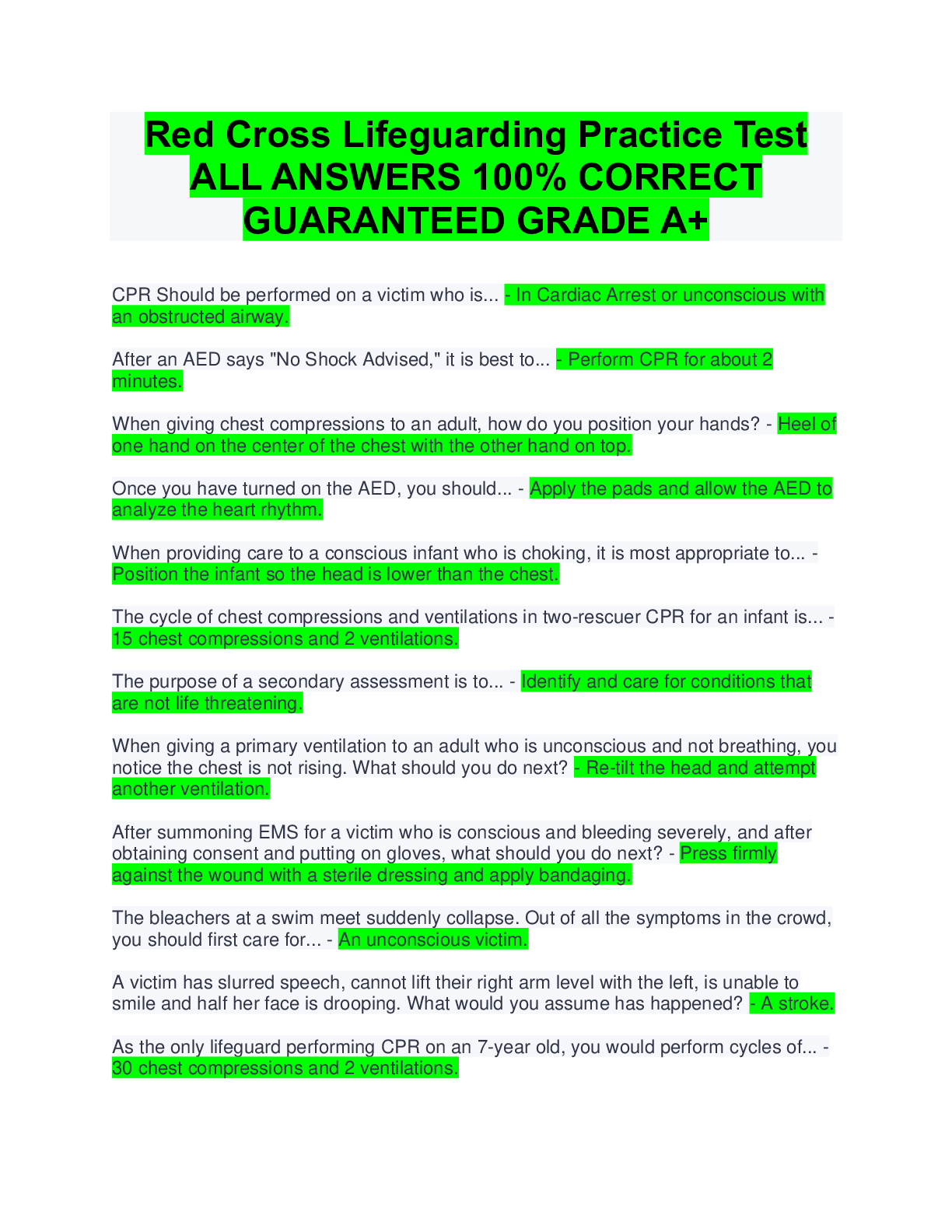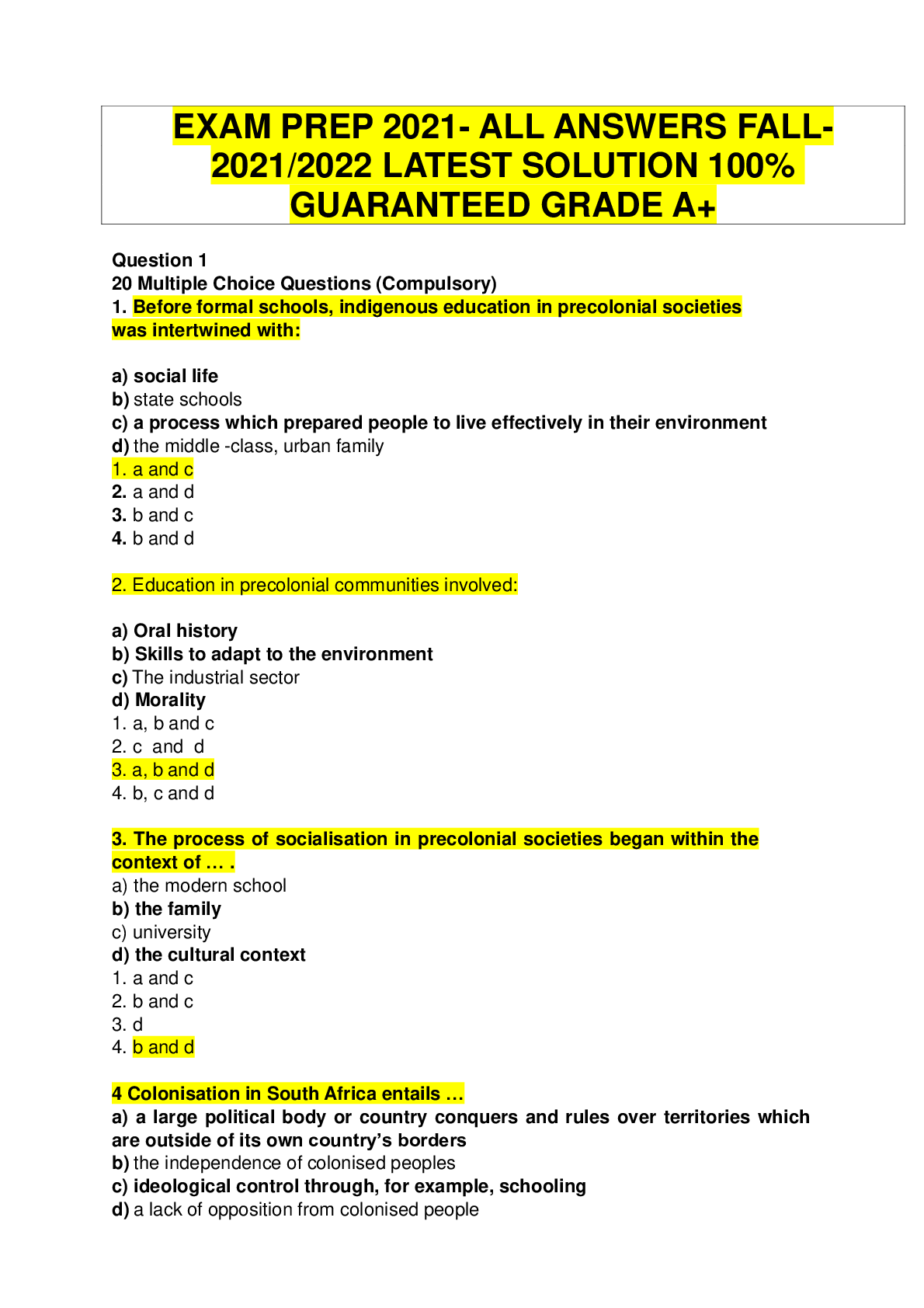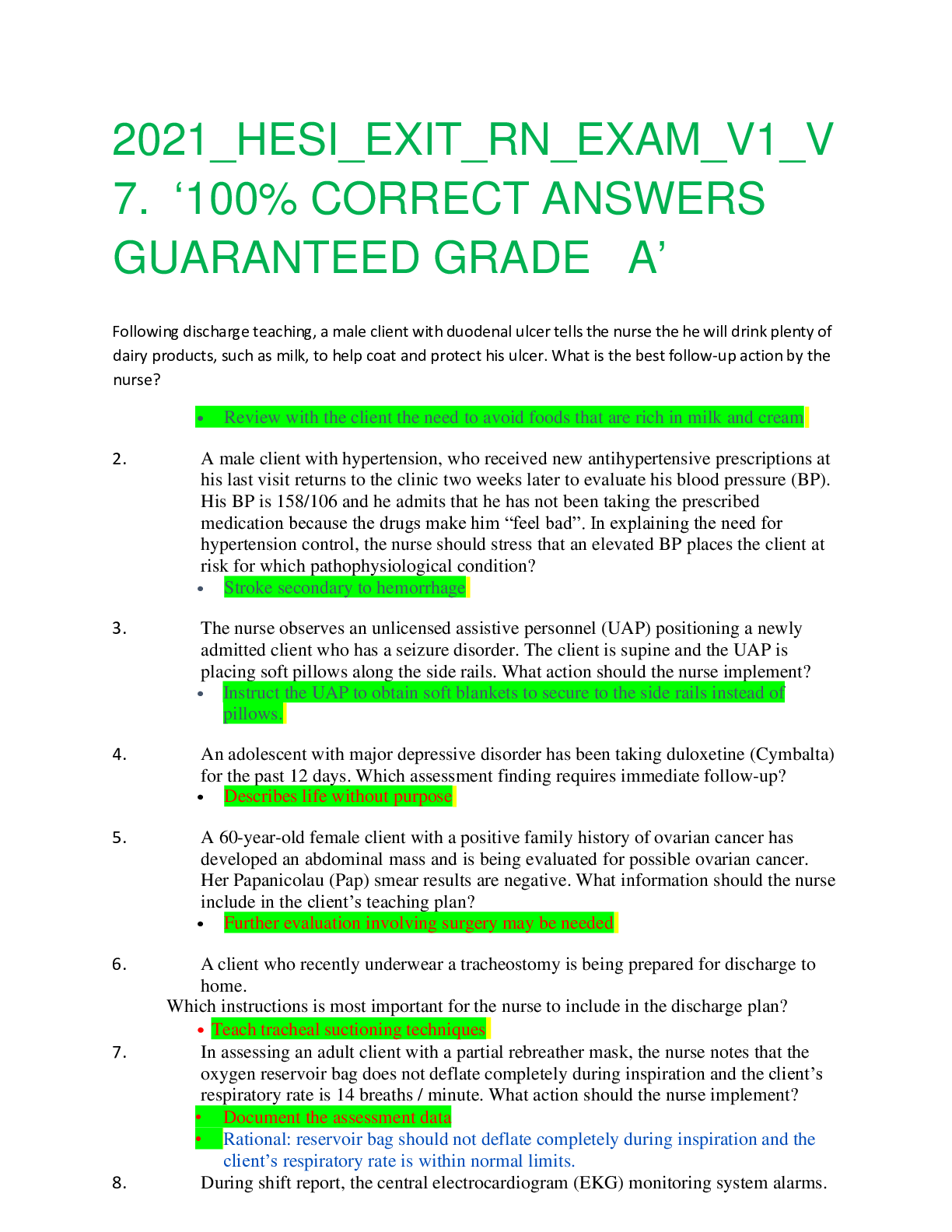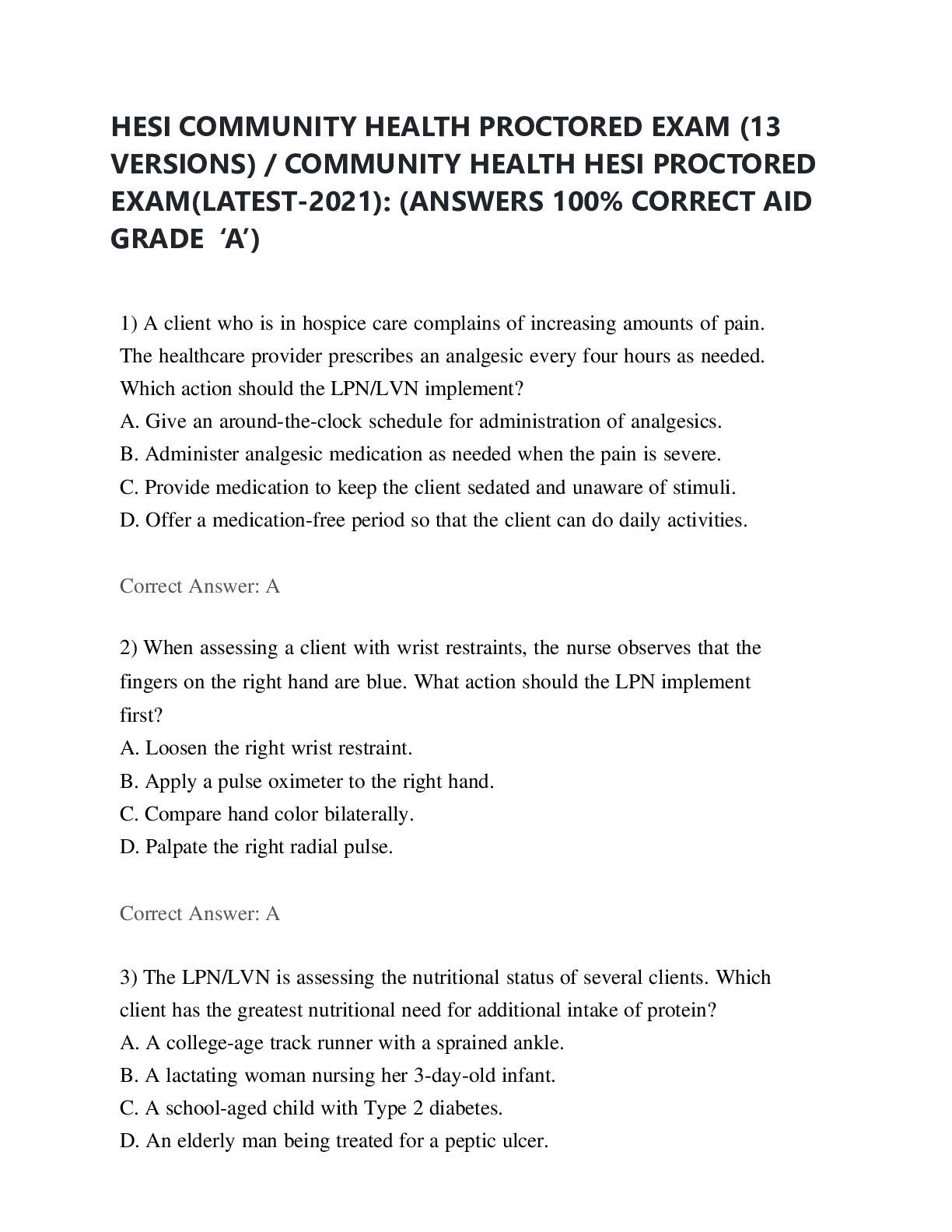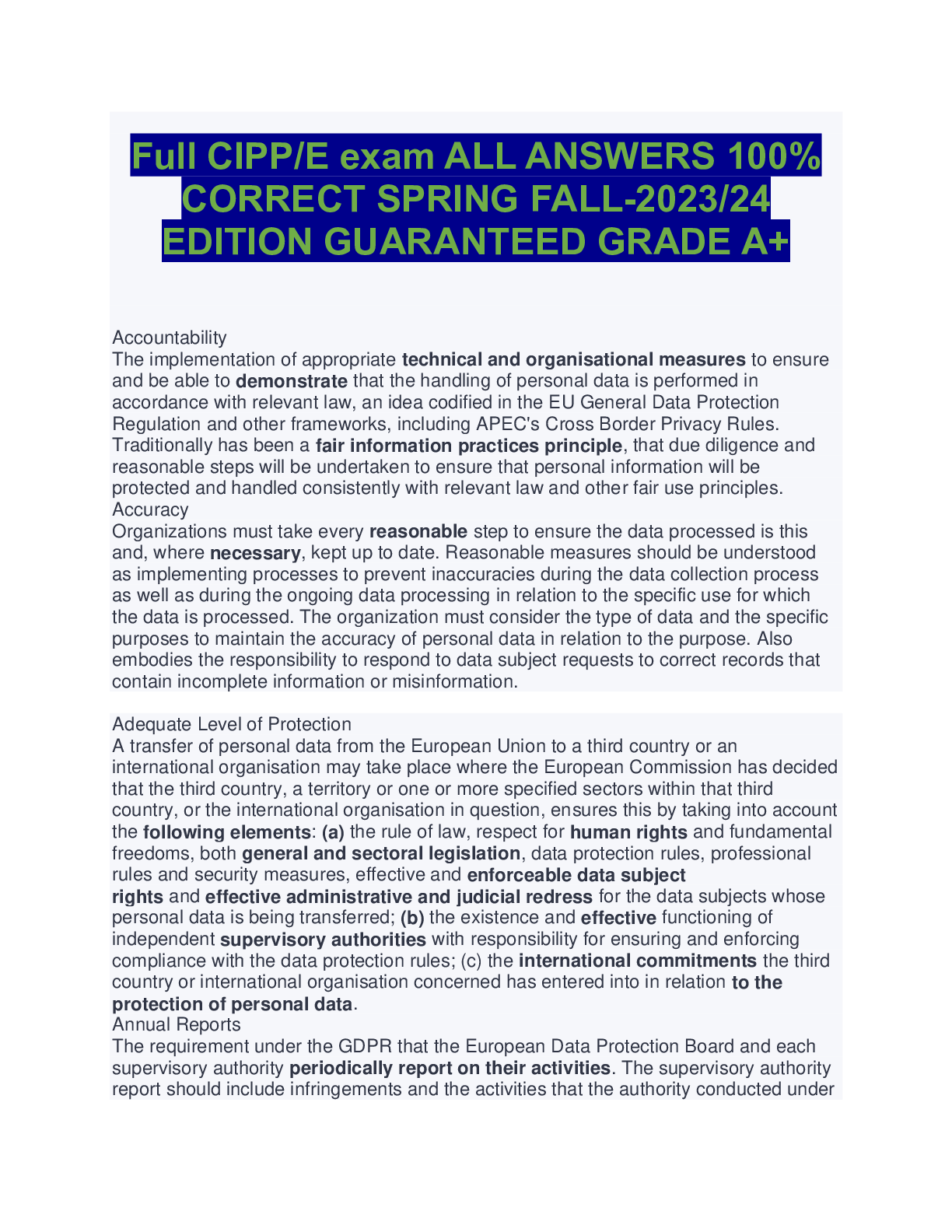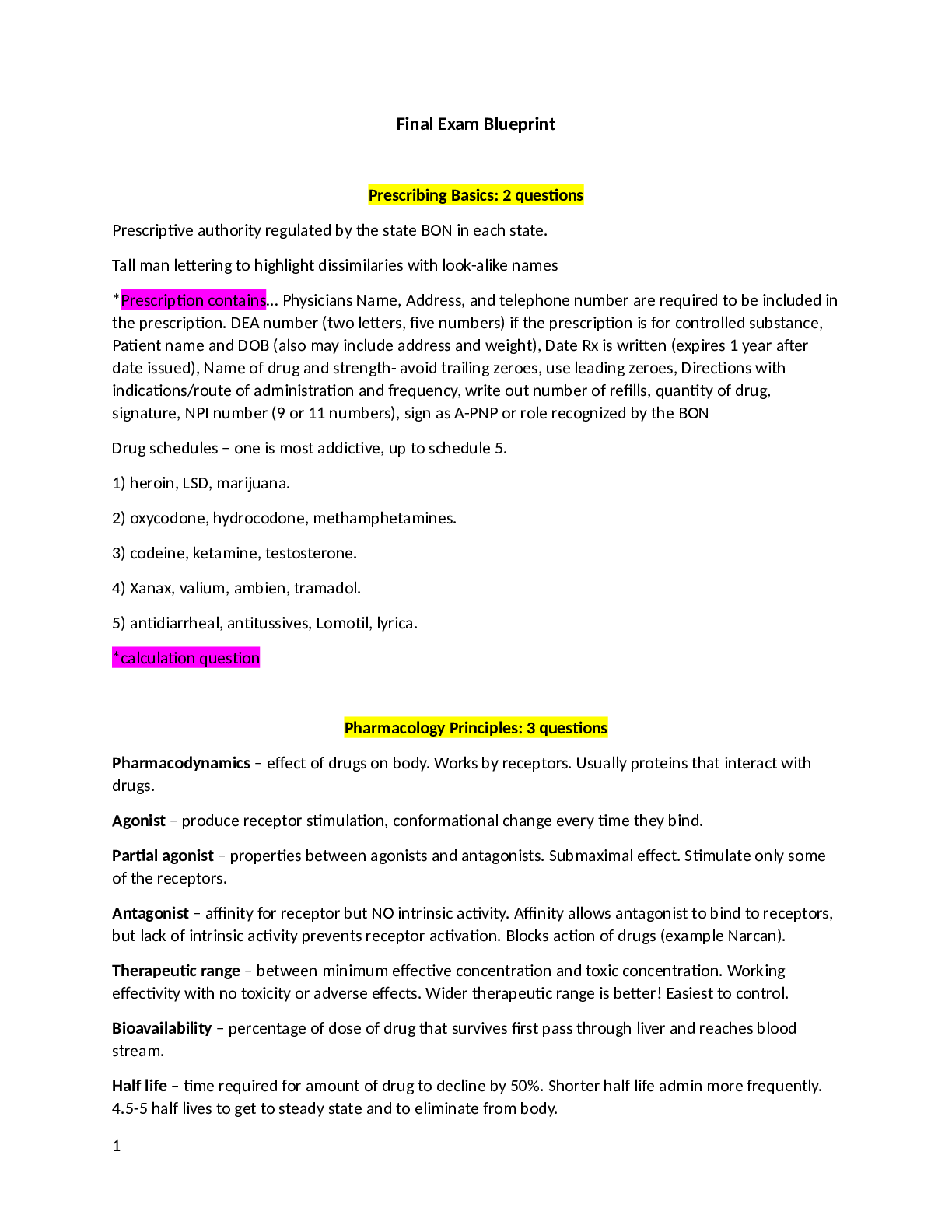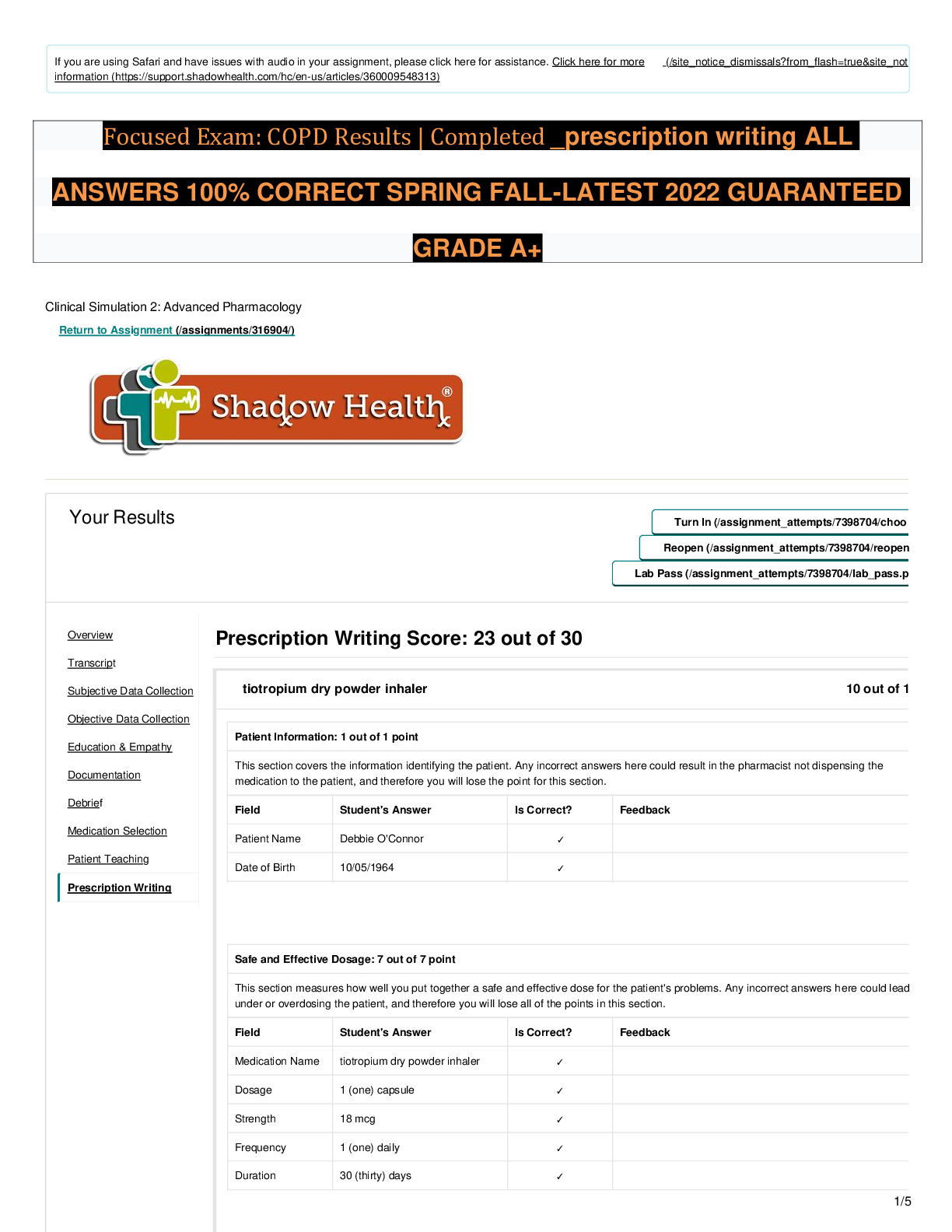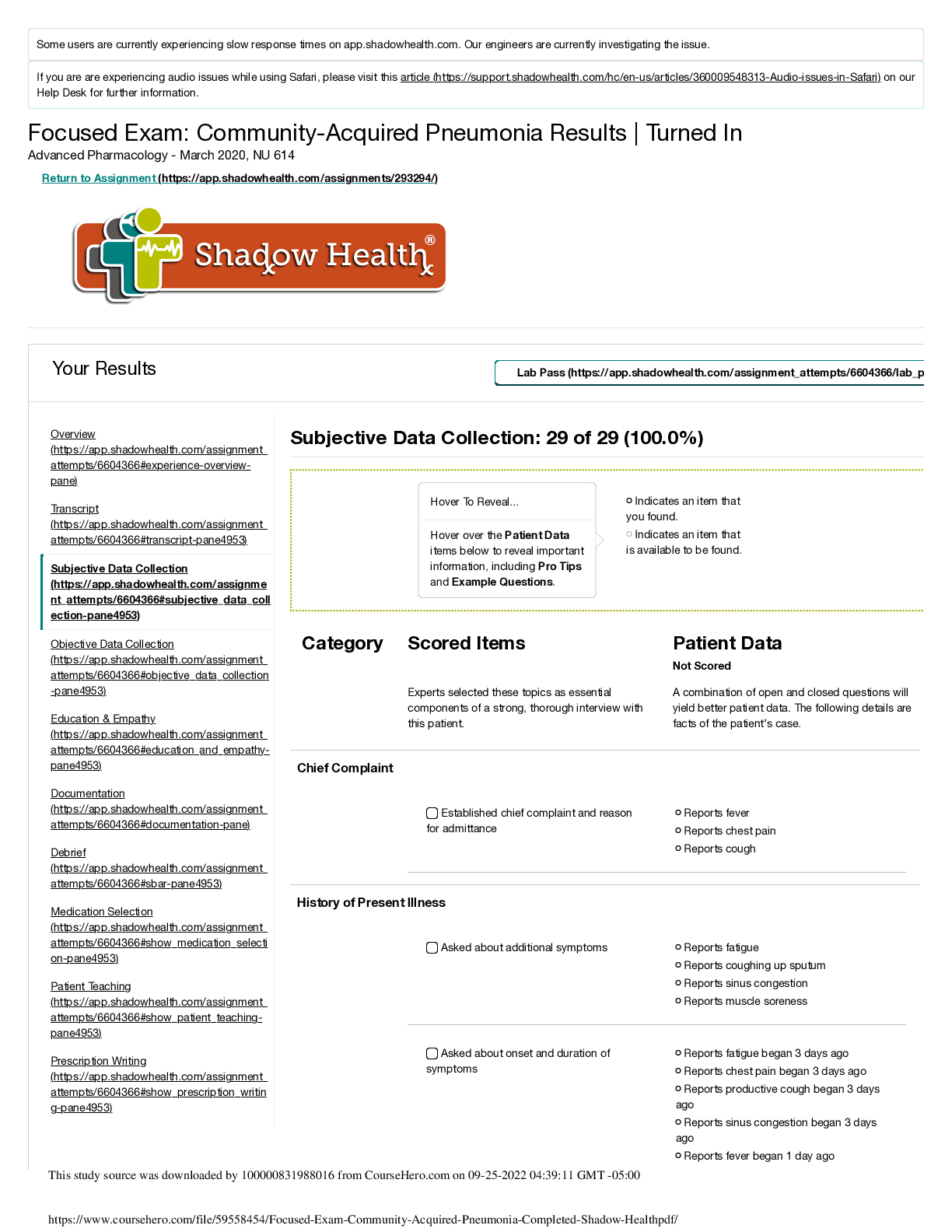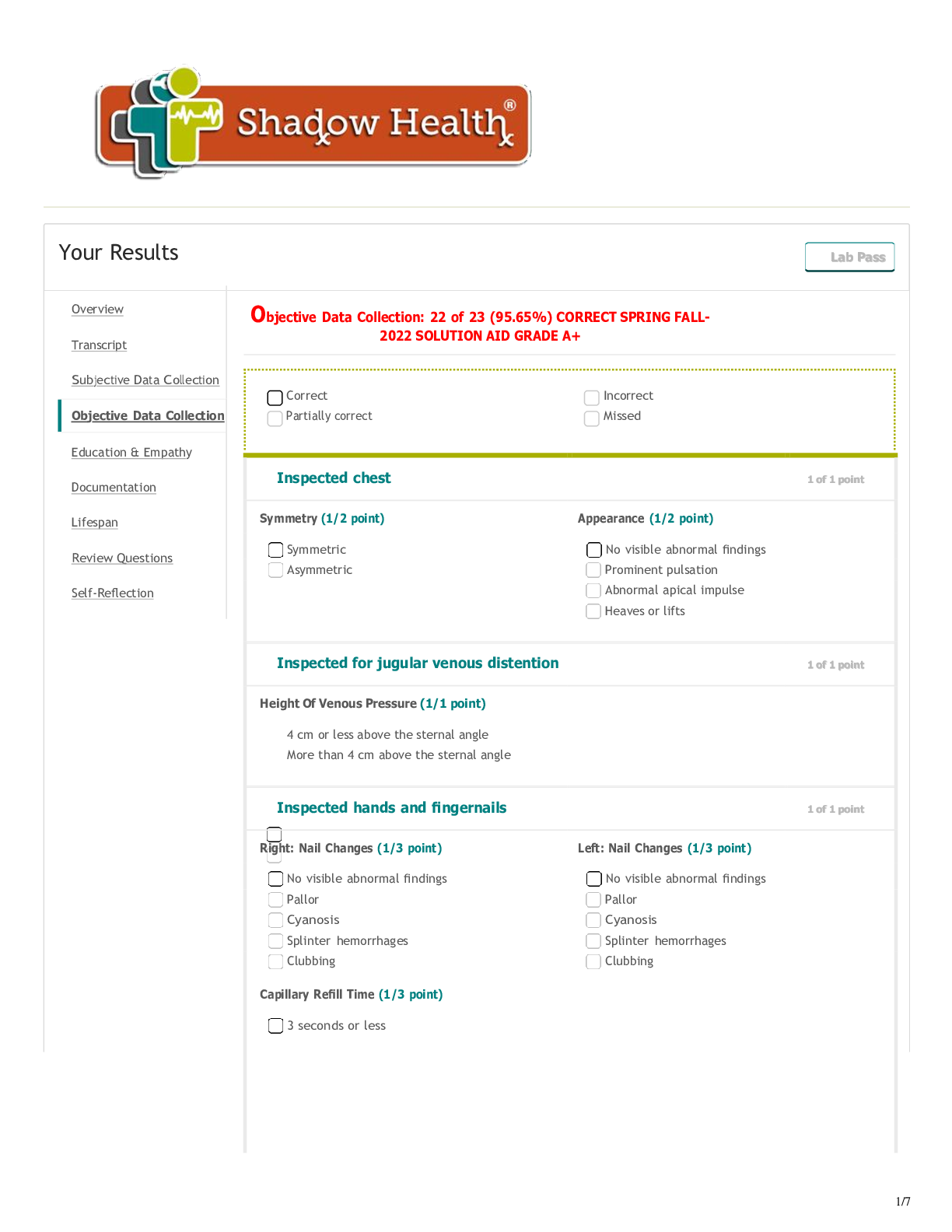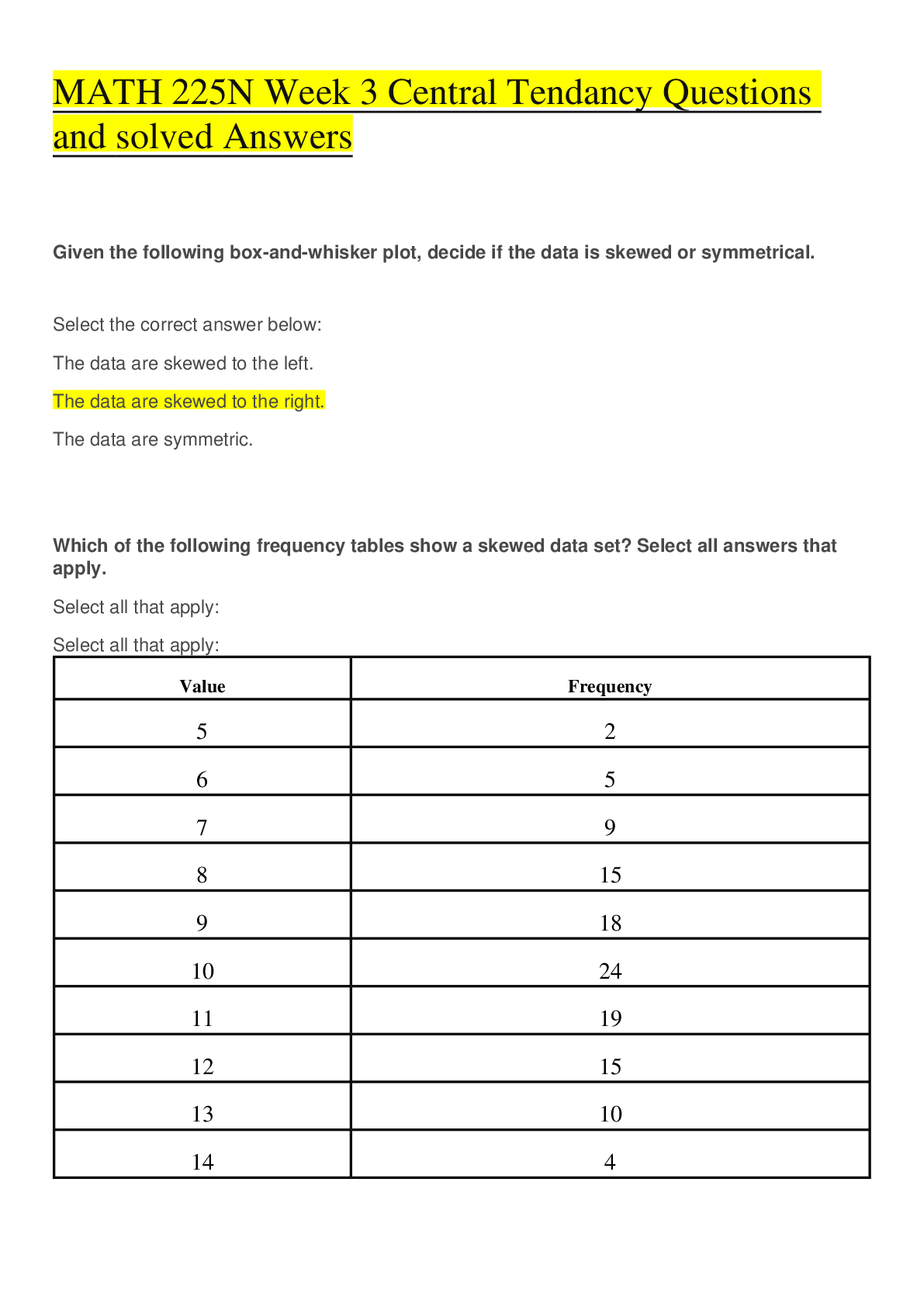PN CAPSTONE NCLEX QUESTIONS ALL ANSWERS 100% CORRECT GUARANTEE GRADE ‘A’
Document Content and Description Below
1. If a male client experienced a cerebrovascular accident (CVA) that damaged the hypothalamus, the nurse anticipate that the client has problems with: a. Body temperature control. b. Balance and... equilibrium c. Visual acuity d. Thinking and reasoning 2. A female client admitted to an acute care facility after a car accident develops signs and symptoms of increased intracranial pressure (ICP). The client is intubated and placed on mechanical ventilation to help reduce ICP. To prevent a further rise in ICP caused by suctioning, the nurse anticipates administering which drug endotracheal before suctioning? a. Phenytoin (Dilantin) b. Mannitol (Osmitrol) c. Lidocaine (Xylocaine) d. Furosemide (Lasix) 3. After striking his head on a tree while falling from a ladder, a young man age 18 is admitted to the emergency department. He’s unconscious and his pupils are nonreactive. Which intervention would be the most dangerous for the client? a. Give him a barbiturate b. Place him a mechanical ventilation c. Perform a lumbar puncture d. Elevate the head of his bed 4. When obtaining the health history from a male client with retinal detachment, the nurse expects the client to report: a. Light flashed and floaters in front of the eye b. A recent driving accident while changing lanes c. Headaches, nausea, and redness of the eyes d. Frequent episodes of double vision 5. Which nursing diagnosis takes highest priority for a client with Parkinson’s crisis? a. Imbalanced nutrition: less than body requirements b. Ineffective airway clearance c. Impaired urinary elimination d. Risk for injury 6. To encourage adequate nutritional intake for a female client with Alzheimer’s disease, the nurse should: a. Stay with the client and encourage him to eat b. Help the client fill out his menu c. Give the client privacy during meals d. Fill out the menu for the client 7. The nurse is performing a mental status examination on a male client diagnosed with subdural hematoma. This test assesses which of the following? a. Cerebellar function b. Intellectual function c. Cerebral function d. Sensory function 8. Shortly after admission to an acute care facility, a male client with a seizure disorder develop status epilepticus. The physician orders diazepam (Valium) 10 mg I.V. stat. How soon can the nurse administer a second dose of diazepam, if needed and prescribed? a. In 30 to 45 seconds b. In 10 to 15 minutes c. In 30 to 45 minutes d. In 1 to 2 hours 9. A female complains of periorbital aching, tearing, blurred vision, and photophobia in her right eye. Ophthalmologic examination reveals a small, irregular, nonreactive pupil - a condition resulting from acute iris inflammation (iritis). As part of the client’s therapeutic regimen, the physician prescribes atropine sulfate (Atropisol), two drops of 0.5% solution in the right eye twice daily. Atropine Sulfate belongs to which drug classification? a. Para sympathomimetic agent b. Sympatholytic agent c. Adrenergic blocker d. Cholinergic blocker 10. Emergency medical technicians transport a 27-year-old iron worker to the emergency department. They tell the nurse, “He fell from a two story building. He has a large contusion on his left chest and a hematoma on the left parietal area. He has a compound fracture of his left femur and he’s oximeter with a manual-resuscitation bag.” Which intervention by the nurse has the highest priority? a. Assessing the left leg b. Assessing the pupils c. Placing the client in Trendelenburg’s position d. Assessing level of consciousness 11. An auto mechanic accidentally has battery acid splashed in his eyes. His coworkers irrigate his eyes with water for 20 minutes, and then take him to emergency department of a nearby hospital, where he received emergency care for corneal injury. The physician prescribes dexamethasone (Maxidex Ophthalmic Suspension), two drops of 0.1% solution to be instilled initially into the conjunctival sacs of both eyes every hour; and polymycin B sulfate (Neosporin Ophthalmic), 0.5% ointment to be places in the conjunctival sacs of both eyes every 3 hours. Dexamethasone exerts its therapeutic effect by: a. Increasing the exudative reaction of ocular tissue b. Decreasing leukocyte infiltration at the site of ocular inflammation c. Inhibiting the action of carbonic anhydrase d. Producing a miotic reaction by stimulation and contraction the sphincter muscles of the iris. 12. Nurse April is caring for a client who under a lumbar laminectomy 2 days ago. Which of the following findings should the nurse consider abnormal? a. More back pain than the first postoperative day b. Paresthesia in the dermatomes near the wounds c. Urine retention or incontinence d. Temperature of 99.2F (37.3C) 13. After an eye examination, a male client is diagnosed with open-angle glaucoma. The Physician prescribes pilocarpine ophthalmic solution (Pilocar), 0.25% gtt I, OU QID. based on this prescription, the nurse should teach the client or a family member to administer the drug by: a. Instilling one drop of pilocarpine 0.25% into both eyes daily. b. Instilling one drop of pilocarpine 0.25% into both eyes four times a daily c. Instilling one drop of pilocarpine 0.25% into the right eye daily d. Instilling one drop of pilocarpine 0.25% into the left eye four times daily 14. A female client who’s paralyzed on the left side has been receiving physical therapy and attending teaching sessions about safety. Which behavior indicates that the client accurately understands safety measures related to paralysis? a. The client leaves the side rails down b. The client uses a mirror to inspect the skin c. The client repositions only after being reminded to do so. d. The client hangs the left arm over the side of the wheelchair 15. A male client in the emergency department has a suspected neurologic disorder. To assess gait, the nurse asks the client to take a few steps; with each step, the client’s feet make a half circle. To document the client’s gait, the nurse should use which term? a. Ataxic b. Dystrophic c. Helicopod d. Steppage 16. A client, age 22, is admitted with bacterial meningitis. Which hospital room would be the best choice for this client? a. A private room down the hall from the nurses’ station b. An isolation room three doors from the nurses’ station c. A semiprivate room with a 32-year-old client who has viral meningitis d. A two-bed room with a client who previously had bacterial meningitis 17. A physician diagnoses a client with myasthenia gravis, prescribing pyridostimine (Mestinon), 60 mg P.O. every 3 hours. Before administering this anticholinesterase agent, the nurse reviews the client’s histo [Show More]
Last updated: 2 years ago
Preview 1 out of 14 pages

Buy this document to get the full access instantly
Instant Download Access after purchase
Buy NowInstant download
We Accept:

Reviews( 0 )
$10.00
Can't find what you want? Try our AI powered Search
Document information
Connected school, study & course
About the document
Uploaded On
Jun 29, 2021
Number of pages
14
Written in
Additional information
This document has been written for:
Uploaded
Jun 29, 2021
Downloads
0
Views
126

